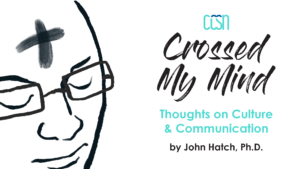 Crossed My Mind: Thoughts on Culture and Communication
Crossed My Mind: Thoughts on Culture and Communication
By John Hatch, Ph.D.
Eastern University (retired)
CCSN Senior Fellow
Column Description: As Christians, we are called to have the mind of Christ. This goes against the grain of our social and cultural conditioning. We seek personal or political advancement; Christ seeks the lost and the least. We grasp for cultural ascendency; Christ descends to the cross of love. This column is dedicated to thinking about culture and communication under the sign of the cross.
November(2) 2022 / November 2022 / October 2022 / August-September 2022 / June-July 2022 / January 2022 / December 2021 / October-November 2021
“Faith-ful Antiracism”: Oxymoron—or Example of Living Faith?
Our last column looked at Beyond Racial Division by George Yancey. I commended Yancey’s commitment to the whole truth about race, including the facts of history and empirical research, the tragic legacy of racial injustice, our common humanity across our differences, and the power of divine grace to reconcile. I discussed Yancey’s “mutual accountability” model for dealing with race issues, which he sees as a better alternative than either colorblindness or antiracism, and concluded by asking whether there could be a faith-based antiracism rooted in the gospel.
If one accepts linguist John McWhorter’s argument in Woke Racism, antiracism amounts to a new religion.[i] Pastor Voddie Baucham’s Fault Lines frames it as tantamount to heresy.[ii]
Christina Barland Edmondson and Chad Brennan would strongly disagree. They are the authors of a new book titled Faithful Anti-Racism: Moving Past Talk to Systemic Change.[iii] Using “faithful” in two senses—steadfastly committed and full of faith—they ground faithful antiracism in Scripture rather than contemporary thought trends. In addition, their approach is informed by their own national research (involving more than three thousand participants), input from a host of Christian experts and leaders, and a desire to promote productive dialogue within churches and Christian organizations. Their book frames antiracism in terms of Christian character and competence: developing the understandings, virtues, and practices needed to undo the lingering effects of racism.
Whether or not a reader agrees with every claim they make, it is evident that Edmondson and Brennan strive to present truth in fullness, informed by the gospel. They repeatedly refer to Scripture as the warrant for faithful antiracists’ moral commitments, perspectives on human nature, hopefulness for positive change, and models for facilitating change. For instance, chapters 2, 3, and 4 tie faithful antiracism to having scriptural wisdom, applying the Bible, and standing for justice as modeled by Christ and selected Christian figures. And chapter 8 is devoted to the example of early believers (mostly in the book of Acts) in dealing with differences and inequities in the church.
Likewise, Edmondson and Brennan demonstrate a strong commitment to historical and empirical facts. In chapters 4, 5, and 6, they unpack evidence from past history, recent/present societal trends, and trauma research to demonstrate that racism’s legacy still needs to be overcome through proactive effort. Indeed, Faithful Anti-Racism devotes much more attention to the tragic history and legacy of white racism in America than does Beyond Racial Division. To document inaccurate beliefs and unhelpful attitudes about race in society and the church, Edmondson and Brennan extensively cite results from the Race, Religion, and Justice Project (2019-2020), a study that surveyed more than three thousand individuals and interviewed over one hundred leaders, as well as conducting focus groups and ethnographic studies in churches.
Instead of pitting structural explanations against individualistic explanations of personal success, Edmondson and Brennan recommend a both/and perspective, “acknowledging the powerful impact of structural dynamics as well as acknowledging the powerful role of decisions, abilities, and morals in determining our life experiences.”[iv]
On close examination, there are both significant differences and overlaps between their approach and Yancey’s mutual accountability model. Yancey generally agrees with antiracism’s diagnosis of systemic racial inequity but chooses not to embrace the antiracist label or approach because it seems to embody a superior and accusatory mindset that puts many people (especially whites) on the defensive, alienating potential allies. Edmondson and Brennan assume that racism is sin and undoing the effects of sin is obviously biblical, so being “antiracist” should be uncontroversial—as long as it can be shown that barriers to racial inclusion and equality persist in society and the church, and that there are models of addressing racial inequality in Scripture. Faithful Anti-Racism presents an abundance of information on systemic racism and biblical models for addressing cultural division. However, it doesn’t explicitly acknowledge (as Yancey does) that some contemporary incidents have mistakenly been characterized as racist (whether through honest misperception, strategic posturing, or outright deception).[v] Doing so would have increased readers’ confidence that the authors are not cherry-picking data.
To their credit, Edmondson and Brennan emphasize the power and grace of God as essential to faithful antiracism. Instead of demonizing or belittling individuals who oppose racial justice efforts or fail to see how racism still operates, they suggest that the real enemy is “spiritual forces of darkness.”[vi] As such, Edmondson and Brennan emphasize the need for prayer, even providing recommended prayers at the end of every chapter. They encourage would-be antiracists to lean into the grace and truth of Christ, which frees His followers to “acknowledge areas of sin and weakness” and “be challenged to do better (truth) while also being reminded that all of our sins are forgiven through Christ’s sacrifice for us (grace).”[vii] When dealing with fellow Christians who resist racial justice efforts, they exhort faithful antiracists to prayerfully “approach every conversation with grace, humility, patience, and love.”[viii]
The subtitle, “Moving Past Talk to Systemic Change,” might seem to indicate a devaluation of conversation, but Edmondson and Brennan highlight the importance of good communication, which includes “courageous confrontation” (as modeled by the church in the book of Acts) along with the aforementioned humility and patience.
If secular antiracists have a tendency to silence or marginalize anyone they deem insufficiently anti-racist, Faithful Anti-Racism emphasizes a very different approach, patterned after “the perfect mentor, Jesus,” who “modeled connection before content” and “drew near to others offering hope, grace, truth, healing, and a robust social ethic.”[ix] Edmondson elaborates:
“We are best able to hear the hardest truths from those who have shown us the greatest unconditional love . . . We employ the methods of truth and grace to show our formal and informal students that we are committed to their growth and seek their release from internalized racial inferiority and superiority. We offer each learner a space that seeks to challenge them but not embarrass their often-insecure state.”[x]
One might fault this statement for assuming a teacher-student relationship rather than a dialogue among equals. But surely it behooves us to adopt the posture of a learner when presented with information and guidance by people with more expertise and experience regarding race? Of course, good teaching invites critical thinking, questioning, and mutual discovery (especially with adult learners), not mere absorption and regurgitation. This appears to be what Edmondson and Brennan are modeling and advocating.
Still, their book prioritizes information-giving and exhortation over collaborative conversation. If the approach Yancey models in Beyond Racial Division is designed to meet truth-seekers and well-meaning skeptics in the middle and foster ongoing (if slow-going) conversations, Faithful Anti-Racism is designed to provide knowledge, convince us to address systemic racism, and expedite practical action. We might wonder which approach is better.
The example of St. Paul and Barnabas seems apropos here. In the book of Acts, we read that Barnabas wanted to invite their young protégé, Mark, to accompany them on the next leg of their mission journey, while Paul felt Mark’s prior departure from them in Pamphylia disqualified him for the trip. In the end, they agreed to disagree: Barnabas took Mark with him to Cyprus, while Paul took Silas to visit the churches they had planted in Syria and Cilicia.[xi] Barnabas made room for a less-committed partner to grow in faithfulness, while Paul felt compelled to move ahead more expeditiously.
Likewise, in the work of racial justice and reconciliation, some advocates (e.g., Yancey) challenge us to slow down, listen, and build common ground, while others (e.g., Edmondson and Brennan) feel compelled to advance toward deep structural change more directly. Depending on the context, one approach or the other may be more appropriate.
Despite their disagreement, Paul and Barnabas continued to affirm one another as fellow workers for the gospel.[xii] Surely those who follow the “collaborative racial conversations” approach and those who pursue the “faithful anti-racism” path can do likewise?
Notes
[i] John McWhorter, Woke Racism: How a New Religion Has Betrayed Black America (Portfolio, 2021).
[ii] Voddie T. Baucham Jr., Fault Lines: The Social Justice Movement and Evangelicalism’s Looming Catastrophe (Hackensack, NJ, 2021).
[iii] Christina Barland Edmondson and Chad Brennan, Faithful Anti-Racism: Moving Past Talk to Systemic Change (Downers Grove, IL, 2022).
[iv] Edmondson and Brennan, Faithful Anti-Racism, 27.
[v] As an example, Yancey discusses the case of Ricardo Muñoz, who was shot by police after charging them with a knife. George A. Yancey, Beyond Racial Division: A Unifying Alternative to Colorblindness and Antiracism (Downers Grove, IL: Intervarsity Press, 2022), 97.
[vi] Edmondson and Brennan, Faithful Anti-Racism, 146.
[vii] Edmondson and Brennan, Faithful Anti-Racism, 167.
[viii] Edmondson and Brennan, Faithful Anti-Racism, 198.
[ix] Edmondson and Brennan, Faithful Anti-Racism, 176.
[x] Edmondson and Brennan, Faithful Anti-Racism, 175.
[xi] Acts 15:36-41.
[xii] See Colossians 4:10.

